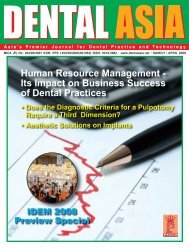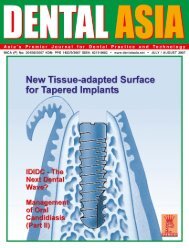Download - Dental Asia
Download - Dental Asia
Download - Dental Asia
You also want an ePaper? Increase the reach of your titles
YUMPU automatically turns print PDFs into web optimized ePapers that Google loves.
CLINICALFEATURE<br />
setting efforts. In the proper conditions, intentions can lead to<br />
higher performance.<br />
Applications to Dentistry: Try to set specific goals for the patient,<br />
for example, to wear the headgear for how many hours, rather<br />
than just using the vague term ‘try your best’.<br />
Reinforcement theory<br />
Reinforcement theory is counter to goal-setting theory. It<br />
proposes that behavior is a function of its consequences. While<br />
goal-setting theory proposes that an individual’s purpose directs<br />
his or her behavior, reinforcement theory argues that behavior is<br />
externally caused. Reinforcement theory ignores factors such as<br />
goals, expectations, and needs; it focuses on what happens<br />
when a person takes an action. The concept of reinforcement<br />
can be used to explain motivation. According to Skinner 7 people<br />
will most likely engage in a desired behavior if they are rewarded<br />
for doing so. These rewards are most effective if they<br />
immediately follow a desired response. Behavior that is not<br />
rewarded or is punished is less likely to be repeated. The<br />
emphasis is on positive reinforcement, not punishment, people<br />
should ignore, not punish, unfavorable behavior. Even though<br />
punishment eliminates undesired behavior faster than no<br />
reinforcement does, its effect is often only temporary and may<br />
later have unpleasant side effects including dysfunctional<br />
behavior such as conflicts, absenteeism, and withdrawal.<br />
Applications to Dentistry: Patient should be immediately praised<br />
(positive reinforcement) every time when a good response (e.g.<br />
good oral hygiene) is encountered.<br />
Equity Theory<br />
Being human, one tends to compare oneself with others. If<br />
someone offered one US$10,000 a month on one’s first job after<br />
graduating from a dental school, one would probably jump at the<br />
offer and report to work enthusiastic, ready to tackle whatever<br />
needed to be done, and certainly satisfied with one’s pay. How<br />
would one react, though, if one<br />
found out a month into the job that<br />
a coworker, your classmate with<br />
comparable school results and<br />
with comparable work experience<br />
— was getting US$11,000 a<br />
month? One would probably be<br />
upset! Even though in absolute<br />
terms, US$10,000 is a lot of<br />
money for a new graduate to make<br />
(and one knows it!), that suddenly<br />
is not the issue. One sees the<br />
issue now as relative rewards and<br />
what one believes is fair — what is<br />
equitable. The term equity is<br />
related to the concept of fairness<br />
and equal treatment compared<br />
with others who behave in similar<br />
Fig. 1 Expectancy theory of motivation<br />
ways. Equity theory was developed by J. Stacey Adams 8 , it is the<br />
theory that a person compares his/her work’s input-outcomes<br />
ratio with that of relevant others and then corrects any inequity.<br />
Equity theory recognizes that individuals are concerned with their<br />
absolute rewards as well as the relationship of those rewards to<br />
what others receive. When people perceive an inequity, they will<br />
tend to correct the situation 9 . They may distort either their own or<br />
others’ inputs or outcomes; behave in some way to induce others<br />
to change their inputs or outcomes; behave in some way to<br />
change their own inputs or outcomes; the result might be lower<br />
productivity, reduced quality of output, increased absenteeism or<br />
withdrawal from work.<br />
Applications to Dentistry: Patients like to compare themselves<br />
with one another. Inequity may be one of the sources of<br />
dissatisfaction or complaint even the actual services provided are<br />
satisfactory. Conversely, favorable comparisons may significantly<br />
motivate patients.<br />
Expectancy Theory<br />
Last but not the least, the most comprehensive and widely<br />
accepted explanation of motivation to date is Victor Vroom’s<br />
expectancy theory 10 . Although the theory has its critics, most<br />
research evidence supports it 11 . This is the theory that an<br />
individual tends to act in a certain way based on the expectation<br />
that the act will be followed by a given outcome and on the<br />
attractiveness of that outcome to the individual. Three<br />
relationships are important to this theory. Effort-performance<br />
linkage (expectancy) is the probability perceived by the individual<br />
that exerting a given amount of effort will lead to a certain level of<br />
performance. Performance-reward linkage (instrumentality) is the<br />
degree to which an individual believes 1that performing at a<br />
particular level is instrumental in, or will lead to, the attainment of<br />
a desired outcome. Attractiveness of the reward (valence) is the<br />
importance that the individual places on the potential outcome or<br />
reward that can be achieved on the work. The explanation of this<br />
theory can be summed up in the following questions: What<br />
28 <strong>Dental</strong> <strong>Asia</strong> • May / June 2008





